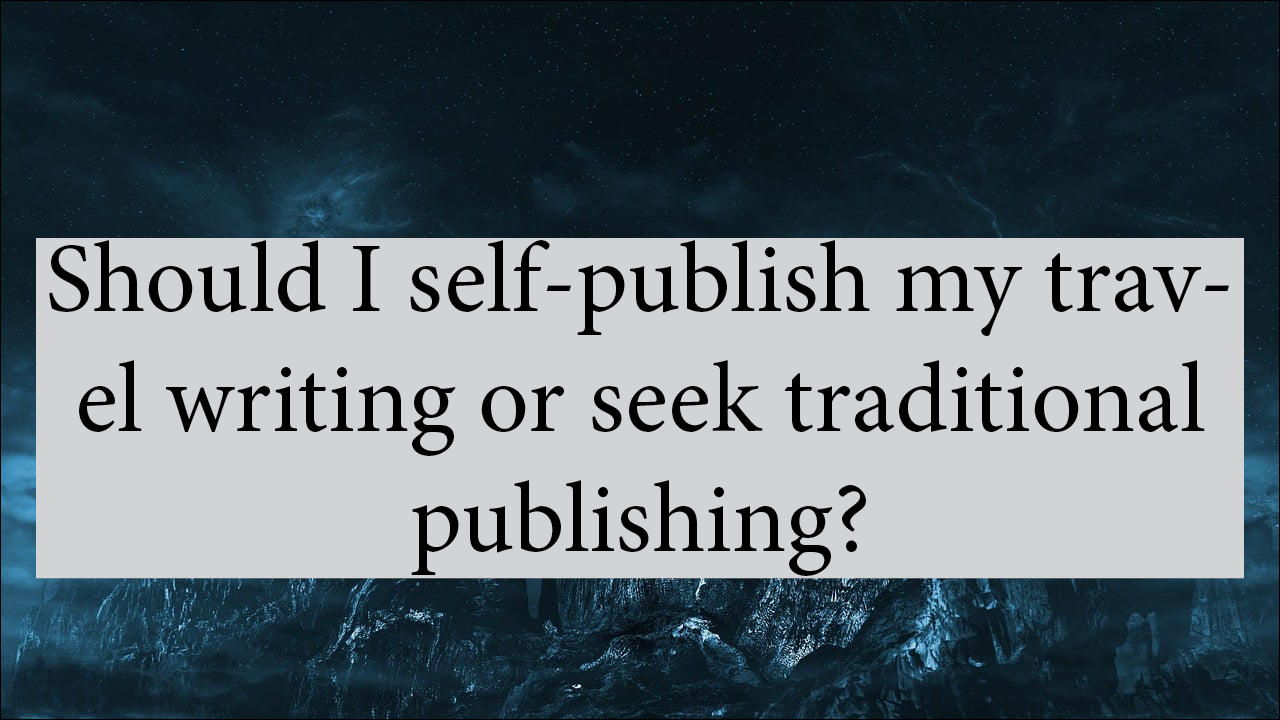Travel writing is a captivating genre that allows authors to share their adventures, experiences, and insights with readers hungry for exploration. As a travel writer, you’ve likely poured your heart and soul into your work, carefully crafting stories that transport readers to distant lands, offering them a glimpse of the world through your eyes. Now, as you stand at the crossroads of publishing, you’re confronted with a critical decision: should you self-publish your travel writing or seek traditional publishing?
This article aims to shed light on the pros and cons of each path, providing you with valuable insights to make an informed decision. We’ll explore frequently asked questions (FAQs) that often trouble aspiring travel writers, helping you navigate the intricate journey from manuscript to publication.
Self-Publishing: For the Trailblazers
FAQ 1: What is self-publishing, and how does it work?
Self-publishing is the process of independently releasing your travel writing without the involvement of a traditional publishing house. It gives you complete creative control and responsibility for all aspects of the publishing process, from editing and design to marketing and distribution.
FAQ 2: What are the advantages of self-publishing travel writing?
1. Creative Control: Self-publishing allows you to retain full creative control over your work, from cover design to content choices.
2. Speed: The self-publishing route is typically faster than traditional publishing, making it ideal for those eager to get their work into readers’ hands quickly.
3. Royalties: You earn higher royalties per book sale as compared to traditional publishing, where royalties are typically lower.
4. Diverse Formats: You can publish in various formats, including e-books, print-on-demand, and audiobooks, catering to a wide range of readers.
5. Global Reach: Self-publishing platforms like Amazon Kindle Direct Publishing offer global distribution, reaching readers worldwide.
FAQ 3: What are the challenges of self-publishing travel writing?
1. Quality Control: Self-published works may suffer from editing, formatting, or design issues if not executed professionally.
2. Marketing: Authors are responsible for marketing their books, which can be time-consuming and challenging for those without marketing experience.
3. Limited Bookstore Access: Self-published books may struggle to gain shelf space in physical bookstores.
4. Credibility: Some readers may perceive self-published books as lower in quality compared to traditionally published works.
Traditional Publishing: The Established Path
FAQ 4: What is traditional publishing, and how does it work?
Traditional publishing involves submitting your manuscript to a publishing house, which, if accepted, will handle all aspects of production, distribution, and marketing. In return, you receive an advance and royalties.
FAQ 5: What are the advantages of traditional publishing for travel writing?
1. Expertise: Traditional publishers provide professional editing, design, and marketing services, ensuring a polished product.
2. Credibility: Being traditionally published adds credibility to your work and can lead to more reviews, media attention, and awards.
3. Bookstore Access: Your book is more likely to be stocked in physical bookstores, increasing discoverability.
4. Advances: You receive an advance payment against future royalties, which can be financially beneficial.
FAQ 6: What are the challenges of traditional publishing for travel writing?
1. Selectivity: Traditional publishers are highly selective and may reject many manuscripts, making it a competitive field to enter.
2. Loss of Control: Authors have limited control over the final product, including cover design and marketing decisions.
3. Timelines: Traditional publishing timelines are often lengthy, with a wait for publication that can take up to two years.
4. Lower Royalties: While you receive an advance, royalties are typically lower than self-publishing.

Making the Decision
The decision to self-publish or seek traditional publishing should align with your goals, preferences, and the specific nature of your travel writing. Consider the following factors:
- Your Creative Vision: Do you want complete control over your work’s presentation, or are you open to collaborative input from publishing professionals?
- Timeline: Are you looking to publish quickly, or are you willing to wait for the longer traditional publishing process?
- Marketing Skills: Do you have the time and expertise to market your work effectively, or do you prefer a publishing house’s marketing resources?
- Financial Considerations: Are you comfortable with the potentially lower upfront payment of self-publishing, or do you need an advance from a traditional publisher?
- Credibility vs. Control: How much importance do you place on the credibility that comes with traditional publishing versus the control of self-publishing?
In the end, the decision is a deeply personal one, and there is no one-size-fits-all answer. Some authors may find success and fulfillment in self-publishing, while others thrive in the traditional publishing world. Whichever path you choose, remember that the journey of a travel writer is an adventure in itself, filled with discoveries and challenges that will shape your literary career.
As you weigh the pros and cons of self-publishing versus traditional publishing for your travel writing, keep in mind that both paths offer unique opportunities and challenges. Ultimately, the right choice will depend on your goals, preferences, and the nature of your work. So, embark on your publishing journey with confidence, knowing that your stories have the power to inspire and transport readers, regardless of the path you choose.
Embrace the allure of adventure travel and cultural experiences with Thoughtful Travel Writer. Let your pen lead the way!






